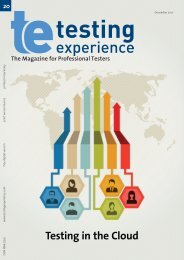Agile Performance Testing - Testing Experience
Agile Performance Testing - Testing Experience
Agile Performance Testing - Testing Experience
Create successful ePaper yourself
Turn your PDF publications into a flip-book with our unique Google optimized e-Paper software.
The case study was conducted to test Reach-U’s (http://www.<br />
reach-u.com/) Workforce Management (WFM) application, a<br />
web-based mobile positioning application developed by Reach-U.<br />
WFM is an application that can observe a workforce’s movement<br />
history, location and send SMSs to personnel via the web browser<br />
client. WFM’s users are primarily companies that would like to<br />
track and plan their workforce locations in real time.<br />
Figure 1: General architecture of WFM<br />
The case study was performed to evaluate the applicability of<br />
model-based testing for testing web services via functional and<br />
load testing – use cases where an operator uses a WFM webclient<br />
to locate targets were tested. Only servers that are part of<br />
WFM were in the scope of the implementation under test (IUT).<br />
A web client was simulated by the test system. It is worth noting<br />
that testing the functionality of the web client itself was out of<br />
the scope of the case study.<br />
The following aspects were evaluated in the case study:<br />
• Overall feasibility of model-based testing technology for<br />
testing web services.<br />
• Applicability of model-based testing technology for load<br />
testing.<br />
Implementation<br />
In the case study we used a test generator producing TTCN-3<br />
test scripts automatically from the State Model (UML) of the IUT,<br />
© iStockphoto.com/kryczka<br />
Case study: <strong>Testing</strong> of Mobile<br />
Positioning Web Services by Dr. Andres Kull<br />
a full-feature TTCN-3 test development and execution platform<br />
and the JMeter (JMet) load tester. Additionally, a system adapter<br />
was developed to communicate between WFM and the TTCN-3<br />
test development and execution platform as well as the JMeter<br />
load tester.<br />
Firstly, the TTCN-3 scripts generator was used to generate TTCN-3<br />
test cases from the system model.<br />
The test cases generated from the<br />
model were executed on the TTCN-<br />
3 test development and execution<br />
platform. Test cases controlled the<br />
execution of JMeter as well. JMeter<br />
was used to generate the load for<br />
the server infrastructure of WFM.<br />
The test cases instructed JMeter<br />
to vary the load. Therefore, the test<br />
cases were communicated to two<br />
counterparts – the IUT and JMeter.<br />
In between, the system adapter<br />
was developed. The system adapter<br />
connected to the TTCN-3 test development<br />
and execution platform<br />
to WFM and JMeter. The interface<br />
of the system adapter towards<br />
WFM provided HTTP message traffic<br />
over TCP/IP. In this way the test<br />
cases ran on the TTCN-3 execution platform and simulated the<br />
WFM web-client. The interface of the system adapter to JMeter allowed<br />
JMeter to be controlled by HTTP GET messages over TCP/IP.<br />
Figure 2: The test environment of the WFM<br />
76 The Magazine for Professional Testers www.testingexperience.com









